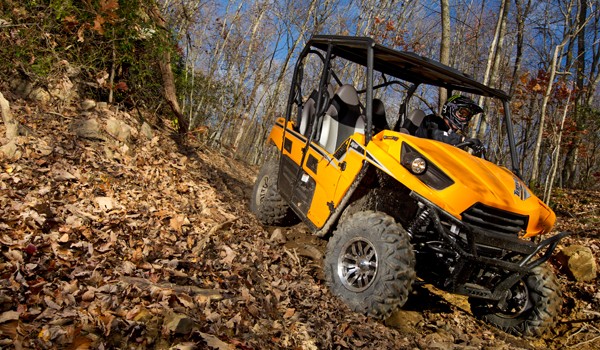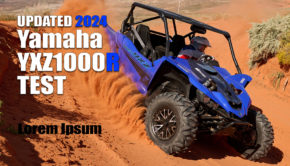2012 Kawasaki Teryx4 Test: With Video
Double the fun with Kawasaki’s four-seat adventure vehicle!
Perhaps the biggest contributor to the popularity of side-by-sides is their ability to bring a friend along for the ride. For 2012, Kawasaki is looking to double the fun all over again, with the introduction of their all-new four-seat Teryx4.
Kawasaki invited us down to Brimstone, a ride area in Huntsville, Tennessee . They manage nearly 19,200 acres, featuring over 300 miles of trails and roads in the heart of Appalachia. The trails offer offer varying degrees of tightness and technicality, providing a great first place to put the new machine to the test.
The Test

To boost performance, valve timing, lift, and ignition timing were all addressed in addition to a newly designed exhaust.
The Teryx4 is nearly all-new from the ground up, although it shares an enhanced version of the 749cc engine found in the two-seated Teryx. The 90-degree, v-twin engine features four valves and single overhead cams per cylinder. To boost performance, valve timing, lift, and ignition timing were all addressed in addition to a newly designed exhaust.

To increase horsepower and reduce noise, the Teryx4 has a new intake system, now located under he hood.
The fuel injection’s 32-bit ECU determines the correct amount of air and fuel in varying conditions. Its payload is delivered through 36mm throttle bodies, now featuring 12-hole fine-atomizing injectors for consistent, stable power delivery.
To increase horsepower and reduce noise, the Teryx4 has a new intake system, now located under he hood. The intake’s new snorkel and duct design lead up to the new, easy-to-access air box, with nearly three times the volume of the one used on the standard Teryx. .
The cooling system was also upgraded to meet the demands of the larger vehicle. Larger capacity radiator hoses attach to a new, larger radiator. A new fan, forces air directly over the t-twin-engine providing additional cooling.
The CVT transmission still features high and low ranges, plus neutral and reverse, but has otherwise gone through some major changes. The Teryx4 is the industry’s first model to make use of a centrifugal clutch–– located between the crankshaft and CVT drive pulley–– which eliminates belt shock and makes throttle control easier..
The improvements in power were notable throughout the RPM range, most notably in the low-end and midrange. At 1,616 pounds, its additional 214 pounds compared to the two-seat model was virtually undetectable. Power is crisp and smooth, accelerating well out of corners or up steep inclines. Overall power is quite adequate, even with four occupants on board.
The new CVT transmission worked superbly. Engagement is instantaneous and virtually undetectable allowing you to crawl along with good throttle control in any range. The engine braking system wasn’t overpowering, providing a pretty natural compression braking sensation when letting off the gas or cruising down a hill. In low range, you can crawl some descent declines with little or no need to touch the brakes.
Kawasaki ditched their variable differential lock, replacing it with a more standard two-wheel, four-wheel, and four-wheel drive with differential lock design. A rotating switch on the dashboard selects drive settings. While the control of the old system was neat, the three-position system simplifies things a bit and is just as effective.
The Teryx4’s all new chassis features a wide-body design, with the frame rails protruding at the outermost part of the body. This helps protect the body panels from encounters with trailside obstacles and seem to add to interior room.

Newly designed, dual A-arms front and rear, work in conjunction with new shocks at all four corners.
Kawasaki focused on maximizing rigidity, and keeping the larger vehicles’ weight down. They started with a double X style frame. Occupants are protected by a (ROPS) certified roll cage. The use of large diameter, thin-walled tubing adds rigidity and reduces weight. The engine was mounted mid-ship and is protected underneath by steel plates.
Newly designed, dual A-arms front and rear, work in conjunction with new shocks at all four corners. The base model features preload adjustable, non-reservoir equipped, gas-charged shocks up front, and fully adjustable reservoir equipped shocks out back. The EPS, LE, and Camo models all feature fully adjustable, reservoir-equipped shocks at both ends. The new suspension package delivers 7.8-inches of travel up front and 8.3-inches out back. Kawasaki added a torsion bar to the front of the Teryx to help prevent front-end dive.
All of the Teryx 4 models, except the base model, feature Electric Power Steering. Their EPS system uses wheel and engine speed, plus ateering forces, to determine the amount of assistance needed.
An 86-inch wheelbase is only 10-inches longer than the one on the two-seat model. An overall length of 125.2-inches is only 8.9-inches longer. The 4-seater is 3.5-inches wider with a width of 62-inches. Ground clearance is good at 10.8-inches.
Premium quality 26-inch Maxxis Bighorn 2.0 tires mounted on 12- inch wheels are standard equipment on the Teryx4. They were a great addition to the vehicle’s handling and ride quality, rarely demanding the use of four-wheel drive, even in the slop. Despite abusing them with the throttle on rocky climbs, we never got a flat.

It is hard to fault the handling of the Teryx4. Perhaps the coolest thing about its handling is that it goes almost anywhere that the original Teryx goes.
It is hard to fault the handling of the Teryx4. Perhaps the coolest thing about its handling is that it goes almost anywhere that the original Teryx goes. Its longer wheelbase adds stability at speed, and makes steep climbs easy to deal with. Cornering stability was also quite good. All four wheels stayed planted on downhill, off-camber turns, thanks to the front torsion bar.
With an almost 17-inch shorter wheelbase than the RZR 4, the Teryx4 can negotiate sections in one pass that would have you looking for reverse on the Polaris. The Teryx4 goes where it is pointed responding well to wheel input. The Power steering models enjoyed light steering with a notable reduction in steering feedback. The EPS was its biggest asset in four-wheel drive with differential lock engaged. For the short time we drove it, the steering on the base model seemed pretty light with low levels of bump feedback noticeable through the steering wheel.
One day is a short time in which to feel out a machine and start playing with suspension settings. The stock settings were good enough that we didn’t feel the immediate need to make changes. The shocks have a firm positive feel to them even when loaded with four occupants. We barely found the suspension’s limits on one or two occasions when fully loaded. With the back seats empty, the ride remains balanced. We never felt the suspension bottom with one or two riders on board, yet the shocks didn’t become harsh or bouncy.
Hydraulic disc front brakes with dual piston calipers and Kawasaki’s signature sealed, oil-bathed-multi-disc rear brake slow the vehicle. Power is ample for steep descents or scrubbing off speed in a hurry. Modulation is easy and they offer good feel at the pedal.
The Teryx4’s interior received some extremely significant updates. The new doors function well.They help keep legs in, trail obstacles out, and are a huge cosmetic upgrade.
Kawasaki tells us the 4 has class-leading occupant room and we believe it. The new high-back, bucket seats were comfortable and did a good job of keeping you in place. The front seats can be unbolted and moved forward or backward if desired. Anti-cinch seat belts were installed, reducing punishment on your collarbone.
There’s a grab bar for the rear passengers, and a nice, left, side-mounted handle for the front passenger. The right side handhold is mounted on the front downtube of the roll cage, not a location we’re thrilled about. Added interior features include a premium digital display with all the info you could ask for. Storage includes a glove box; dual cup holders, front and rear; plus several small, open stash boxes in the back. The Teryx4 lost some of its rear cargo space and its dump bed for the four-seat model. The rear bed can still hold 249 pounds of cargo and can easily hold a large cooler, gas can, and a few other small items. A two-inch receiver offers 1,300 pounds of towing capacity.
The base model retails for $13,399, with the most equipped EPS LE model retailing for $15,199. In addition to the standard features found on the base model, all of the upgraded models, including the Camo, receive the upgraded front shocks, power steering, and door covers. The EPS and EPS LE models feature two-tone seat covers. The EPS LE also features a roll cage cover and cast aluminum wheels.
The Conclusion
The Teryx4 isn’t just a four-seat Teryx; it is an all-new vehicle that has been improved upon in nearly every way! We’re confident it would be fun in the dunes, and, perhaps, the best four-seat option for the woods. Even if we only planning on hauling two people, if cargo bed space isn’t a huge issue, we might consider the four-seat model over the two-seater. Kawasaki has literally outdone themselves with the Teryx4 and added a very viable four-seat sport model to the side-by-side market.
2012 Kawasaki Teryx4™ 750 4×4 Specifications*
| Engine: | Liquid-cooled, 90-degree, four-stroke V-twin |
| Valve system: | SOHC, four valves per cylinder |
| Displacement: | 749cc |
| Starting system: | Electric |
| Bore x stroke: | 85 x 66mm |
| Compression ratio: | 9.3:1 |
| Fuel system: | DFI®, 2 x Mikuni 36mm throttle bodies |
| Ignition: | TCBI w/ electronic advance |
| Transmission: | Continuously variable belt-drive transmission with high and low range, plus reverse, and Kawasaki Engine Brake Control |
| Final drive: | Selectable four-wheel drive with Variable Front Differential Control, shaft |
| Frame: | Double-X design using large-diameter, thin-walled, high-tensile tubular steel |
| Front suspension / wheel travel: | Adjustable dual A-arm with gas charged shocks / 7.8 in. |
| Rear suspension / wheel travel: | Adjustable Independent Rear Suspension (IRS) with fully adjustable, gas charged, reservoir shocks / 8.3 in. |
| Front tires: | Maxxis 26×9-12 |
| Rear tires: | Maxxis 26×11-12 |
| Front brakes: | Dual hydraulic discs with 2-piston calipers |
| Rear brake: | Sealed, oil-bathed, multi-disc |
| Overall length: | 125.2 in. |
| Overall width: | 62.0 in. |
| Overall height: | 77.3 in. |
| Wheelbase: | 86.1 in. |
| Ground clearance: | 10.8 in. |
| Lighting: | (2) 35W headlights, (2) 8 W taillight, 24 W stoplight |
| Cargo bed capacity: | 249 lbs., 47.6 W x 17.9 L x 8.7 in. H |
| Towing capacity: | 1,300 lbs. |
| Curb weight: | 1,616 lbs. |
| Fuel capacity: | 7.9 gal. |
| Instruments: | Multi-function digital meter with speedometer, fuel gauge, clock hour meter, odometer, dual trip meter and parking brake, CVT belt, R/N/P/4WD, water temp and oil pressure indicators |
| Color: | Sunbeam Red, Scout Green |
| MSRP: | $13,399 |
| Warranty: | 6 Months |
| Wholesale distributor: | Kawasaki Motors Corp., U.S.A.9950 Jeronimo RoadIrvine, CA 92618949-770-0400www.kawasaki.com |
2012 Kawasaki Teryx4: Ratings
Summary: The Teryx4 isn’t just a four-seat Teryx; it is an all-new vehicle that has been improved upon in nearly every way! We’re confident it would be fun in the dunes, and, perhaps, the best four-seat option for the woods. Even if we only planning on hauling two people, if cargo bed space isn’t a huge issue, we might consider the four-seat model over the two-seater. Kawasaki has literally outdone themselves with the Teryx4 and added a very viable four-seat sport model to the side-by-side market.















